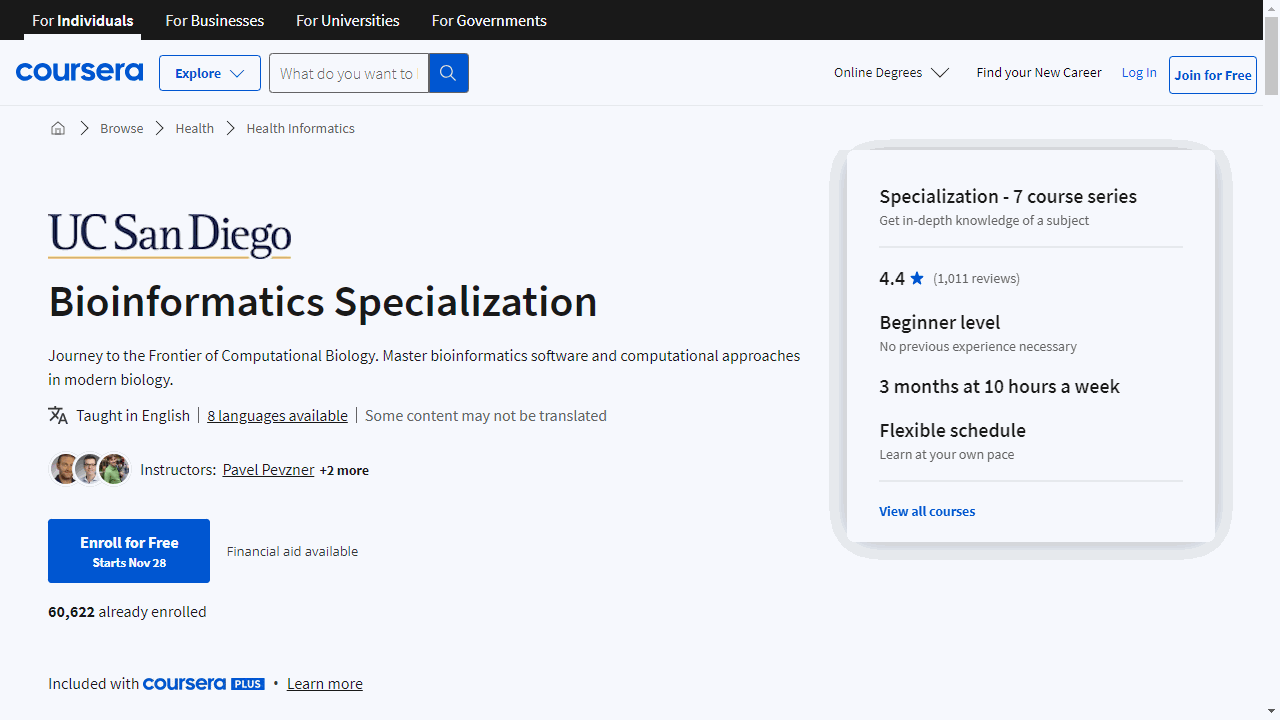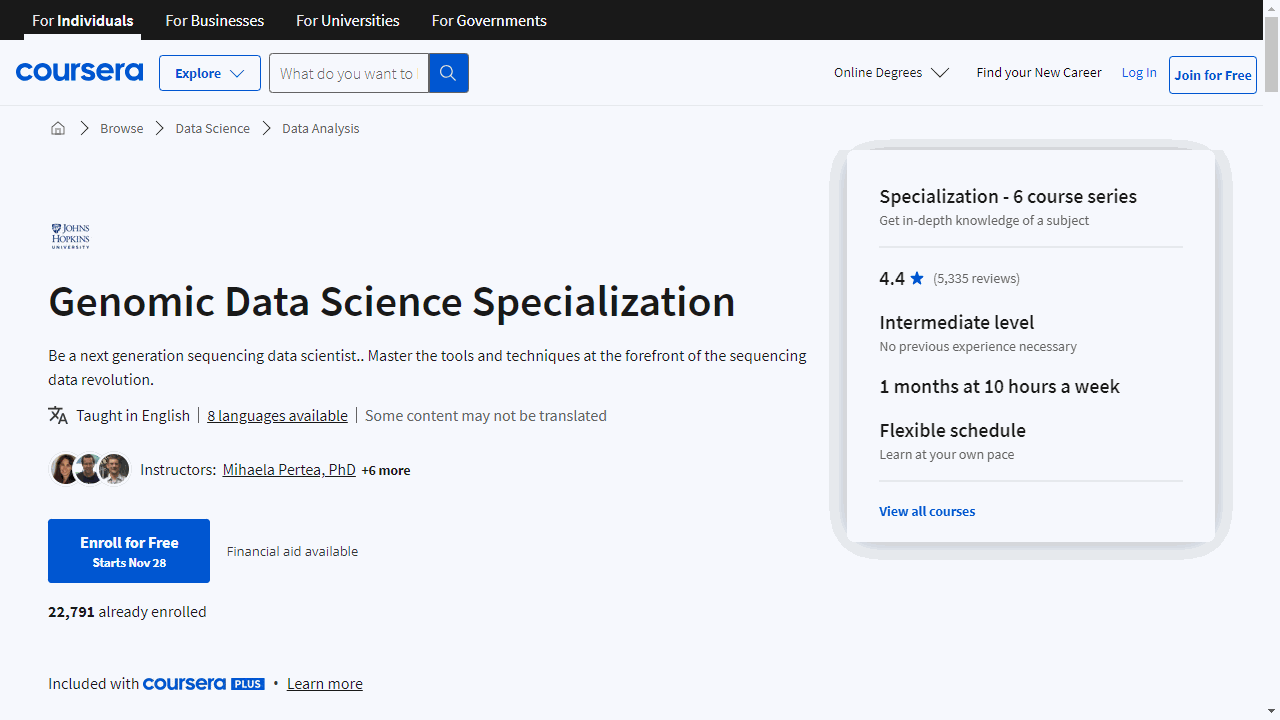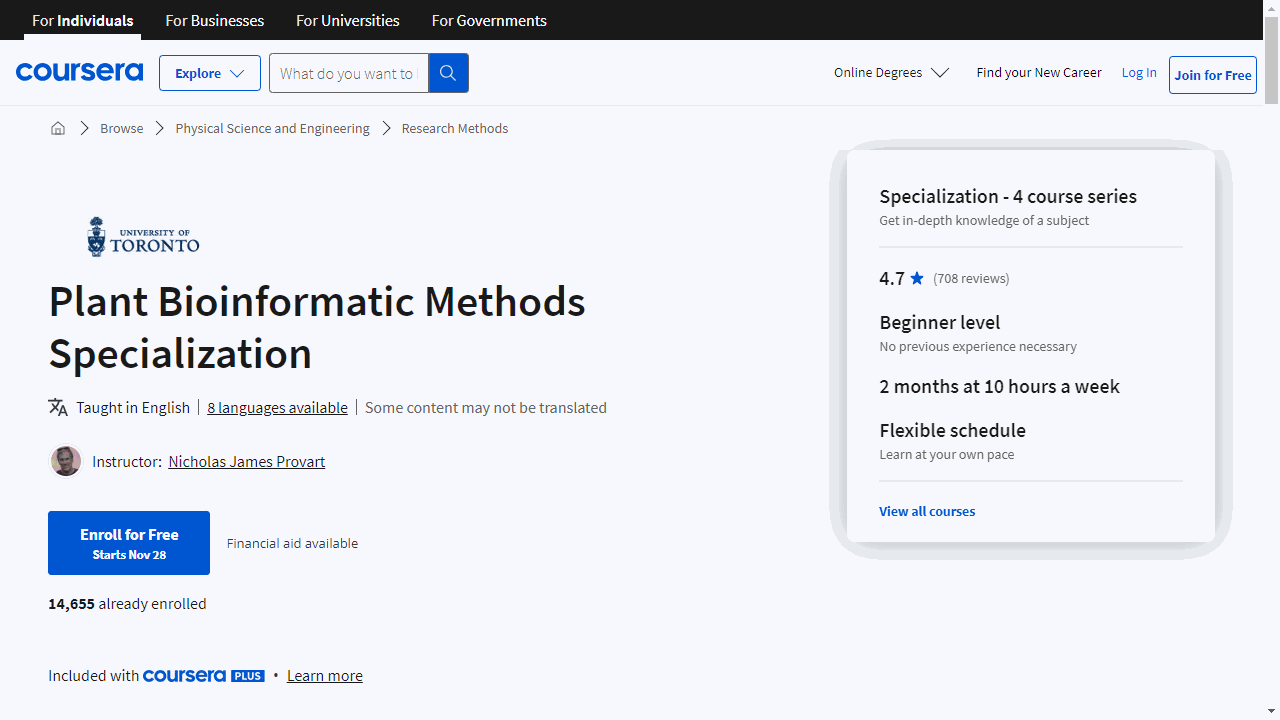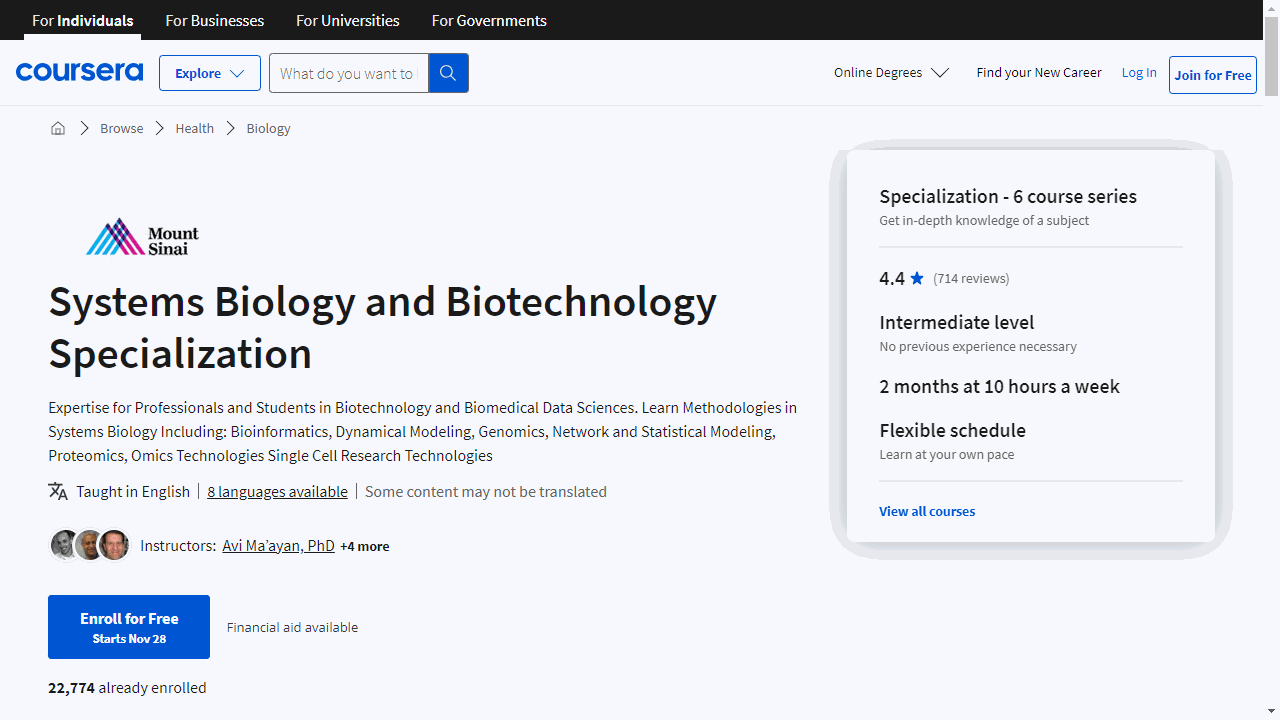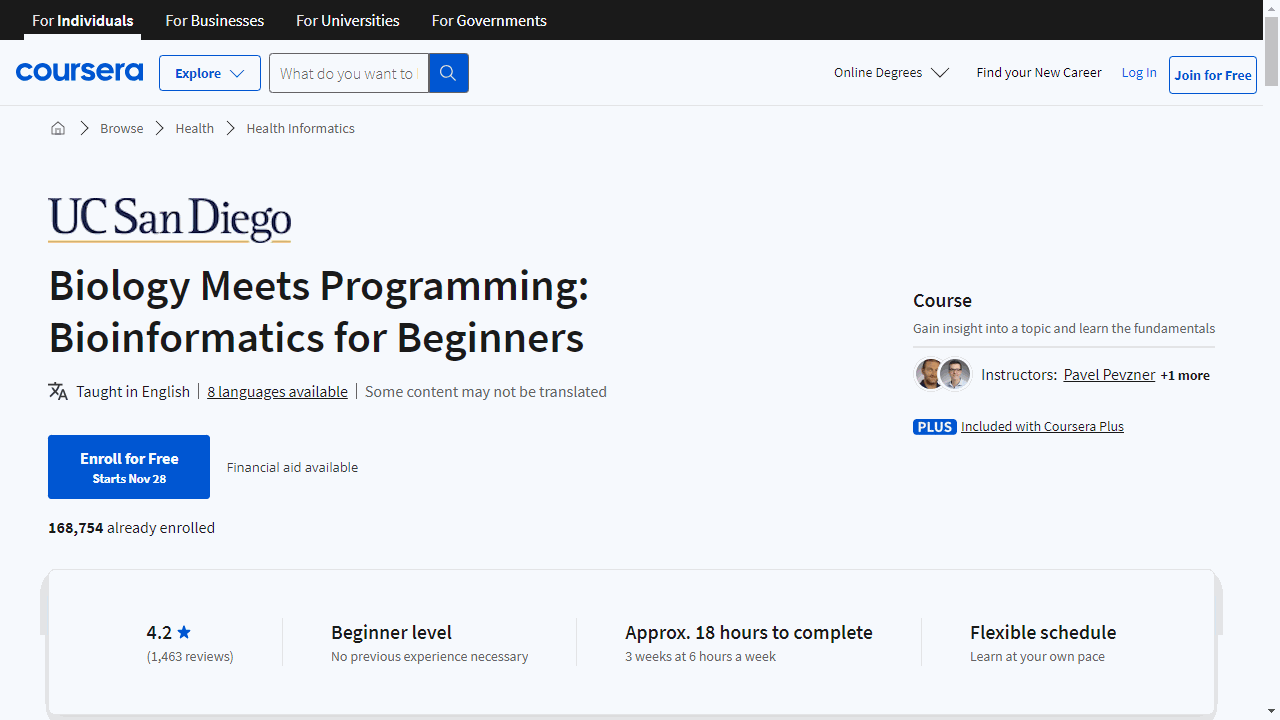Bioinformatics is a rapidly growing field that combines biology, computer science, and statistics to analyze and interpret biological data.
By mastering bioinformatics, you can unlock the secrets of DNA, proteins, and other biological molecules, contributing to groundbreaking discoveries in medicine, agriculture, and environmental science.
Finding a reputable and engaging bioinformatics course on Coursera can be a challenge, as there are many options to choose from.
You’re looking for a program that provides a comprehensive understanding of the field, introduces you to essential tools and techniques, and equips you with the skills needed to succeed in this dynamic industry.
For the best bioinformatics course overall on Coursera, we recommend the Bioinformatics Specialization offered by the University of California, San Diego.
This program is a comprehensive seven-course pathway that covers essential concepts like Python programming, algorithm development, and the use of professional bioinformatics software.
It provides hands-on experience with real-world applications, making it an ideal choice for beginners and experienced learners alike.
This is just the beginning of our exploration into the world of bioinformatics courses on Coursera.
We have compiled a comprehensive list of recommendations, catering to different learning styles and career goals.
Whether you’re interested in specific areas like genomic data science, plant bioinformatics, or bacterial bioinformatics, we have options for you.
Keep reading to discover the perfect bioinformatics course for your journey!
Bioinformatics Specialization
This specialization, offered by the University of California, San Diego, is rich in content, teaching you Python programming, algorithm development, and the use of professional bioinformatics software.
It’s a comprehensive pathway for anyone looking to decode genetic information and apply it to real-world biological challenges.
Starting with “Finding Hidden Messages in DNA (Bioinformatics I),” you’ll delve into the world of DNA replication and circadian rhythms, using algorithms to uncover genomic secrets.
This course isn’t just theoretical; it’s a hands-on experience where you’ll use software to investigate bacterial genes, giving you a taste of actual bioinformatics work.
“Genome Sequencing (Bioinformatics II)” introduces you to genome assembly, akin to solving the largest jigsaw puzzle with DNA fragments.
You’ll explore the sequencing of genomes and the pressing issue of antibiotic resistance, applying bioinformatics tools to sequence genomes of pathogenic bacteria.
The third course, “Comparing Genes, Proteins, and Genomes (Bioinformatics III),” focuses on the evolutionary differences between organisms.
You’ll employ dynamic programming to compare sequences and examine genome rearrangements, using tools like BLAST for practical sequence alignment tasks.
“Molecular Evolution (Bioinformatics IV)” takes you through constructing evolutionary trees, offering insights into the history of various species.
You’ll apply computational methods to evolutionary questions, from virus origins to the dinosaur-bird connection, and use bioinformatics tools to reconstruct evolutionary pathways.
In “Genomic Data Science and Clustering (Bioinformatics V),” data science principles are applied to genetic data, teaching you clustering algorithms and principal components analysis.
This course is about interpreting gene functions and human migration patterns through the lens of bioinformatics.
“Finding Mutations in DNA and Proteins (Bioinformatics VI)” sharpens your ability to detect mutations that influence DNA and protein functions.
Here, you’ll map DNA to reference genomes and use hidden Markov models, a machine learning tool essential for studying rapidly mutating organisms.
The capstone course, “Bioinformatics Capstone: Big Data in Biology,” allows you to apply your skills to real biological data using Illumina’s BaseSpace platform.
You’ll face challenges like tracking disease outbreaks and analyzing gene expression, with the option to create your own genome assembler.
Genomic Data Science Specialization
This suite of courses, crafted by Johns Hopkins University, offers a comprehensive toolkit for mastering computational genomics, a complex bioinformatics field.
Start with “Introduction to Genomic Technologies,” where you’ll grasp the essentials of molecular biology and learn how to apply next-generation genomic sequencing techniques.
This course lays a solid foundation, demystifying the experimental tools and computational concepts crucial for genomic analysis.
“Python for Genomic Data Science” takes you through the Python programming language, a staple in data analysis.
You’ll gain hands-on experience with algorithms and learn to navigate the iPython notebook, a valuable skill for tackling genomic challenges.
In “Algorithms for DNA Sequencing,” the focus shifts to the computational methods used to interpret DNA sequencing data.
Through Python, you’ll develop algorithms and data structures, gaining practical skills by analyzing real genomic datasets.
“Command Line Tools for Genomic Data Science” equips you with the command-line expertise needed to manage large genomic datasets efficiently.
This course is all about harnessing the power of Unix-based tools to streamline your data analysis workflow.
With “Bioconductor for Genomic Data Science,” dive into the Bioconductor project’s resources for genomic analysis.
You’ll enhance your Python skills further and learn to conduct sophisticated data analysis, preparing you for real-world bioinformatics challenges.
Lastly, “Statistics for Genomic Data Science” introduces you to the statistical frameworks that underpin genomic projects.
R programming becomes your tool for data analysis and interpretation, rounding out your statistical acumen in the context of genomics.
Neuroscience and Neuroimaging Specialization
This suite of courses is designed to equip you with a robust understanding of neuroimaging and its applications in neuroscience.
Starting with “Fundamental Neuroscience for Neuroimaging,” you’ll lay a solid foundation.
It’s not just about learning the techniques; you’ll delve into the history and physics behind neuroimaging, understand the brain’s structure and functions, and grasp the experimental designs used in this field.
This course is your comprehensive guide to the essentials of neuroimaging.
Then, “Principles of fMRI 1” takes you deeper, focusing on the most prevalent neuroimaging technique.
You’ll explore the intricacies of fMRI data, from acquisition to analysis.
The course demystifies complex concepts like MR Physics and Generalized Linear Models, making them accessible and applicable.
Building on that knowledge, “Principles of fMRI 2” continues your education in fMRI data analysis.
It’s a seamless transition from the first part, enhancing your ability to interpret and work with advanced neuroimaging data.
Lastly, “Introduction to Neurohacking In R” offers a practical approach to neuroimaging data analysis.
You’ll get hands-on experience with the R programming language, learning to manipulate and analyze brain images.
Skills like inhomogeneity correction and image registration are not just taught; they’re practiced, preparing you to handle real-world neuroimaging challenges.
Each course is rich with relevant content, ensuring you’re not just passively learning but actively engaging with the material.
When you finish, you’ll have a portfolio of skills highly sought after in the bioinformatics field.
Plant Bioinformatic Methods Specialization
Whether you’re aiming for graduate school or a career in molecular medicine, these courses by the University of Toronto provide a robust overview of bioinformatics tools and their applications in plant biology.
Starting with “Bioinformatic Methods I,” you’ll gain practical experience with essential bioinformatics tools.
This course demystifies the complexities of large-scale data by teaching you how to use databases and web-based programs for tasks like sequence alignment and phylogenetic analysis.
It’s a hands-on approach that doesn’t require any programming background, making it accessible if you’re just starting out.
The journey continues with “Bioinformatic Methods II,” where you’ll delve into more advanced topics such as motif searching and protein interactions.
This course builds on the foundation laid in the first part, expanding your skill set into areas like structural bioinformatics and gene expression analysis.
For a deep dive into plant-specific bioinformatics, the “Plant Bioinformatics” course is unmatched.
It covers a wide array of tools tailored to plant genome research, from expression tools to network exploration.
The course structure is engaging, with a mix of theory and practical labs, ensuring you not only learn but also apply your knowledge.
The capstone of the specialization, “Plant Bioinformatics Capstone,” is where theory meets practice.
You’ll use the 33 plant-specific online tools covered in the previous course to investigate a gene of unknown function, culminating in a comprehensive lab report.
This project-based learning solidifies your understanding and prepares you for real-world challenges.
Each course in the specialization is updated regularly, with the latest refresh in 2023, ensuring you’re learning the most current methods and tools.
Systems Biology and Biotechnology Specialization
The journey begins with “Introduction to Systems Biology,” where you’ll grasp the modular nature of cellular systems and acquire the expertise to design and interpret complex experiments.
This foundational course equips you with the computational skills necessary to analyze large datasets and understand cellular behaviors.
As you progress to “Experimental Methods in Systems Biology,” you’ll delve into the practicalities of RNA sequencing, proteomics, cytometry, and live-cell imaging.
This course demystifies the technologies that are pivotal in systems biology, offering a blend of theoretical knowledge and hands-on experience in data analysis.
“Network Analysis in Systems Biology” introduces you to the statistical methods essential for integrating large-scale biological data.
Through practical tutorials, you’ll learn to process and visualize data, gaining the competence to analyze your own research or to explore the computational challenges in the field.
In “Dynamical Modeling Methods for Systems Biology,” you’ll encounter mathematical modeling techniques that provide insights into biological dynamics.
This course is tailored for those who aim to complement laboratory experiments with computational modeling, offering a comprehensive understanding of various modeling approaches.
“Integrated Analysis in Systems Biology” hones your ability to synthesize knowledge through critical reading and analysis of current scientific literature.
This course is designed to prepare you for the capstone project, where you’ll apply your cumulative learning to a practical challenge.
The capstone project is the culmination of the specialization, synthesizing the skills and knowledge from the preceding courses.
It’s an opportunity to apply your learning to a comprehensive project, demonstrating your ability to tackle complex problems in computational biology and biotechnology.
Biology Meets Programming: Bioinformatics for Beginners
This specialization by UC San Diego offers an engaging journey, starting with the fundamentals of DNA replication.
Through a series of optional, in-depth segments, you’ll tackle the question, “Where in the Genome Does DNA Replication Begin?” using interactive texts that simplify complex ideas.
As the course unfolds, you’ll delve into the identification of regulatory motifs—key DNA sequences involved in gene regulation.
The curriculum employs relatable analogies, like dice rolling, to demystify the process of discovering these patterns, making the content accessible and memorable.
Each week’s material is reinforced with interactive texts that complement the video lessons, ensuring an active learning experience.
Should questions arise, weekly FAQs provide timely support.
Bacterial Bioinformatics
This course is a practical deep-dive into bacterial genomics, leveraging the Bacterial Bioinformatics Resource Center (BV-BRC) to equip you with essential skills.
The course begins with a foundational overview of BV-BRC and the Bioinformatics Resource Centers (BRC) program, setting the stage for the technical skills to follow.
You’ll learn to navigate the BV-BRC platform, including how to register, log on, and create a shared workspace—essential for collaborative research.
You’ll then tackle genome assembly, uploading read files, and selecting assembly strategies.
This hands-on approach not only teaches you how to piece together genomic data but also how to interpret the results, providing a comprehensive understanding of genome coverage.
Annotation is next on the agenda.
You’ll upload contig files for annotation and analyze the resulting Genome Report.
This process is crucial for identifying gene functions and understanding bacterial characteristics.
The course also covers Comprehensive Genome Analysis, where you’ll submit jobs and review detailed reports, gaining insights into both assembly and annotation outcomes.
This section solidifies your ability to conduct thorough genomic evaluations.
Building and analyzing codon trees will introduce you to evolutionary relationships among bacteria, while the Protein Family Sorter module will hone your skills in protein family analysis across genomes.
These sections are particularly valuable for comparative genomics.
Proteome Comparison is another highlight, allowing you to select reference genomes and compare proteomes, offering a detailed look at protein-level similarities and differences.
Throughout the course, support is readily available, ensuring you can navigate any challenges and understand how to properly cite PATRIC resources.
Fundamental Skills in Bioinformatics
This course begins with programming in R, introducing you to RStudio where you’ll write your first code.
You’ll grasp data types and structures, from vectors to data frames, essential for managing biological data.
The course emphasizes control flow, teaching you to streamline your code with loops and conditional statements.
You’ll also learn to load and process data, a vital skill for any bioinformatician.
As you advance, the syllabus covers logical operations and data quality control, setting the stage for robust data analysis.
You’ll delve into statistical techniques, applying correlation, linear models, t-tests, and ANOVA to real datasets, honing your ability to interpret complex biological information.
Python, another cornerstone of bioinformatics, is also a key component of this course.
You’ll explore its ecosystem, learn data structures, and practice with NumPy and pandas for data analysis and visualization.
The course culminates with a hands-on case study on RNA-seq data, where you’ll apply your skills in normalization, PCA, and differential expression analysis.
You’ll also tackle scRNA-seq data, learning preprocessing and cell type identification with Python.
Also check our posts on:
